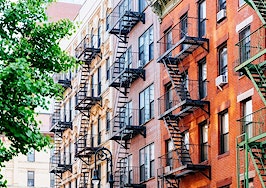Spring Madness is a week-long Inman series analyzing this year’s spring homebuying season. We’re digging into the state of the housing market, the impact of rising mortgage rates, the role of open houses and the rapidly vanishing starter home, among other big issues. It’s total madness, all week long.
In the Southern California neighborhoods where Nate Butcher and his real estate team work, you could mistake the streets outside homes for sale for parade routes.
Cars flood the roads and prospective buyers shuffle in and out of the houses, pausing on front lawns to chat and laugh.
But it’s not a practice run for the St. Patrick’s Day parade. The open house — once banned in California as a pandemic-era health measure — has roared back to life.

Nate Butcher
“People are excited to be out,” said Butcher, an eXp agent. “Even neighbors want to come. I think they’re all excited to be — it feels like some sort of normalcy. So we’re seeing a ton of [open house] activity.”
How California handled the pandemic-era open house is, of course, the exception: While the pandemic certainly slowed open houses in most states as many sellers hesitated to open their doors, it didn’t outright thwart them. But now, as homebuyers begin to feel less hindered by the threat of illness, and homesellers become more willing to invite strangers in, a new dynamic is emerging. At the dawn of the year’s most rapid-fire real estate season, the market is already so hot that the open house isn’t a necessity in the way it once was.
An integral part of the homebuying and selling process for many, the open house is returning to a market that is by no means normal.
A home listing in five Pacific states, including California, Oregon, Washington, Alaska and Hawai’i was more likely to have included a scheduled open house in February of this year than a listing from February of 2019, pre-pandemic, according to Zillow data provided by the search portal’s research team.
It isn’t just on the West Coast, but across the country, that the open house is springing back into action. There has been a marked uptick in open houses in recent weeks, from 11 percent of home listings in December to 16 percent in February. That’s a major gain on the same period last year, when open houses only rose from 8 percent of listings to 9 percent.
While open houses are nearing their pre-pandemic levels, they have yet to eclipse that mark nationwide.
Inman spoke with agents from coast to coast who shared their thoughts on what they’re seeing heading into spring — and the challenges that have held back this time-honored tradition from a full return to normalcy.
A long road
The early weeks of the pandemic struck unilaterally as in-person real estate activity across the country ground to a halt.
A mere 1 percent of home listings in April 2020 had open houses, Zillow’s numbers show. New England states had the highest rate at 2 percent of listings.
Since then, however, a shifting foundation of disparate restrictions at the state and local levels saw open houses follow very different paths on the road to recovery.
Sellers in California were the last to revive the open house due to prolonged bans on the practice throughout much of the state.

Todd Jones
“Back then, we couldn’t do open houses,” said Todd Jones of Rodeo Realty in Los Angeles. “We were all afraid that someone was going to report us, and that we would have some of grievance or violation. We just didn’t want to deal with it.”
Instead of a true open house where multiple groups of guests could mingle at their leisure, agents tried to host versions where only one party at a time could view the house. In some cases, dozens of buyers would line up around the block, waiting hours to see a home, Jones said.
But while the bans there lasted well into May of 2021, the state has also had one of the most bullish recoveries.

Harrison Beacher
Like other agents, Harrison Beacher of the Washington, D.C., area, told Inman that the reluctance to hold open houses was largely driven by sellers, even as buyers continued to show strong interest.
“That definitely tracks with what we’re seeing here,” Beacher said. “Sellers were the ones who were constricting access, really directed to the COVID concerns more than anything else.”
In the D.C. area, where many residents have carefully followed government guidelines throughout the pandemic, Beacher says a full return to normalcy may not be possible until sellers are confident that it’s safe.
Right now open houses are back on the rise in the area, but a number of health-related precautions remain in place, including requiring visitors to wear masks, Beacher said.
‘Back together’
In some areas of the country, the temporary loss of the open house was especially difficult for agents and their clients.
The year prior to the pandemic, roughly 1 in 3 homes in the Pacific states had a scheduled open house, the highest rate of any region in the country, according to Zillow’s data.
In California, the open house was deeply embedded in the fabric of the culture, Butcher said.
“It’s bringing a community back together,” Butcher said.
In general, the parts of the country where open houses were most prevalent before the pandemic were the quickest to bring the practice back up, once they were allowed again.
Much like their counterparts on the opposite end of the country, open house numbers in the New England states east of New York have made a full recovery — and then some.
New England homes listed in recent weeks were even more likely to feature an open house than those listed in the same states in February of 2019.
Open houses were similarly prominent just down the Atlantic coastline in the region including New York, New Jersey and Pennsylvania.

Jennifer Vucetic
While open house rates have not quite matched their levels from before, the recovery in this region has been the third-strongest in the nation, Zillow’s records show.
Jennifer Vucetic, president of the New York State Association of Realtors, said open houses still appear to be lagging near the state’s capital. They were non-existent early in the pandemic, during a time when real estate was not yet deemed an essential business activity, she said.
The open houses there are just now starting to return in good numbers, Vucetic said, but they still have a ways to go before they reach their pre-pandemic levels. Homes have been selling so quickly that sellers haven’t really needed them, she added.
And of course there are the open houses that mirror the realities of the market, where supply is tight and demand is high.
“In Salt Lake City and Boston, police have had to direct the car traffic to open houses,” Redfin CEO Glenn Kelman tweeted on Tuesday. “Even in San Francisco, a line for open houses stretched three blocks.”
In Salt Lake City and Boston, police have had to direct the car traffic to open houses. Even in San Francisco, a line for open houses stretched three blocks. Then this happened in Raleigh: https://t.co/860pmv5InM
— Glenn Kelman (@glennkelman) March 15, 2022
A missing touch
Open houses aren’t the right option for every seller.
In some cases, offers from buyers who attended an open house can be few and far between, while more serious buyers often set up private showings through their agents.
“I have not seen more offers on my properties because of them, but I have seen an eagerness from the sellers to want them, and I’ve seen an eagerness from the buyers to doing them,” Butcher said.
Still, Butcher says if a seller wants an open house, agents should go out of their way to accommodate them.
“I think it’s good for the seller’s mental state,” Butcher said. “When they showcase their home, I think it gives the seller more confidence that … they didn’t leave any money on the table.”
Other times, a seller can land a big score. On a recent weekend in March, Jones said his firm held an open house that attracted approximately 100 groups of buyers over two days and produced more than a dozen offers.
The new resurgence of open houses has been a welcome sight for agents at Jones’ firm, who use them as an opportunity to find prospective buyers.
“I have a team, and I want to give my team a chance to meet buyers,” Jones said. “So I’m having open houses on the weekend so they can do that, and they’re fighting over it. ‘I want to do it. I want to do it.’”
At Butcher’s firm, open houses are his agents’ preferred form of lead generation, he said. At times during the pandemic, he said, it was hard to keep all agents fully engaged without true open houses where they could meet prospective buyers in person instead of over video-conference software.
In the hottest markets, open houses have also been used as a convenient alternative to sellers vacating their homes for an extended period of showings.
“Now, of course, with the market moving fast, it’s actually very convenient to have open houses, because a whole bunch of people come through,” Jones said.
As more states relax their restrictions amid a wave of spring homebuying demand, agents in slower open-house areas are bracing for more interest than they’ve seen in some time.
“I think it will return,” Vucetic said. “I think we’ll definitely know in a month.”













